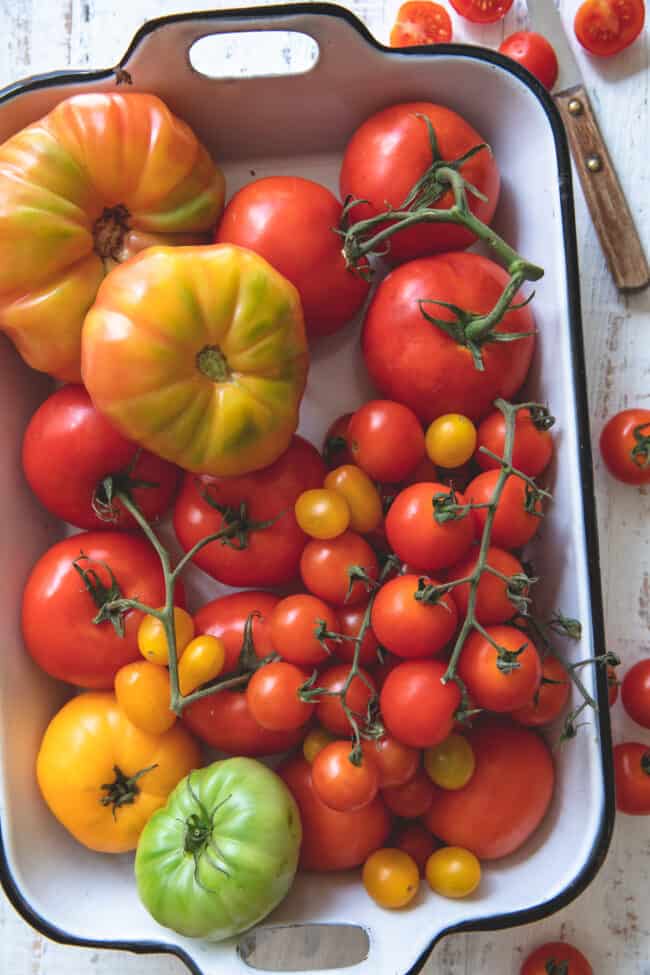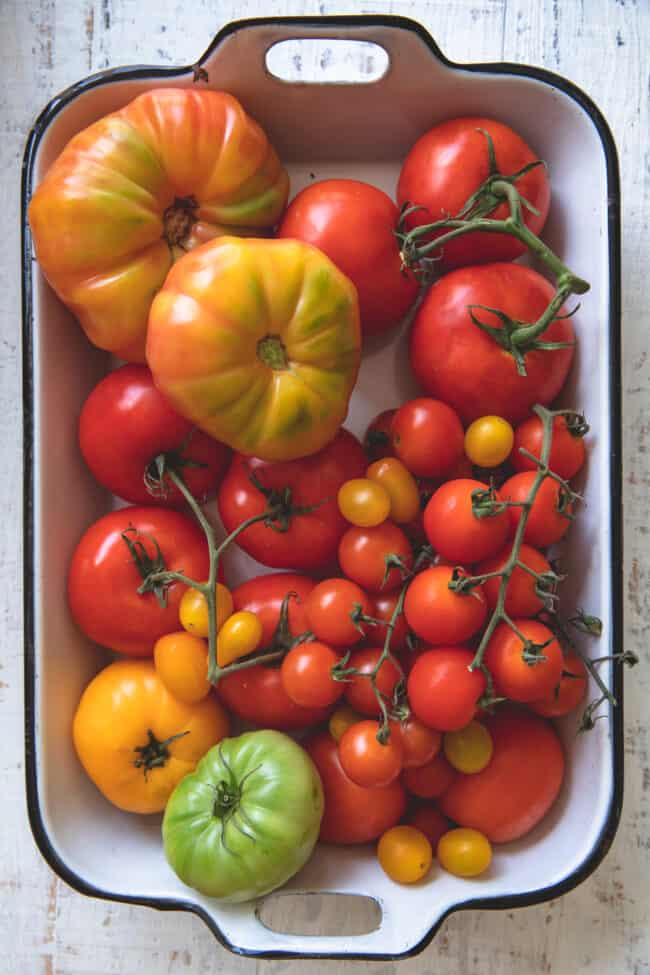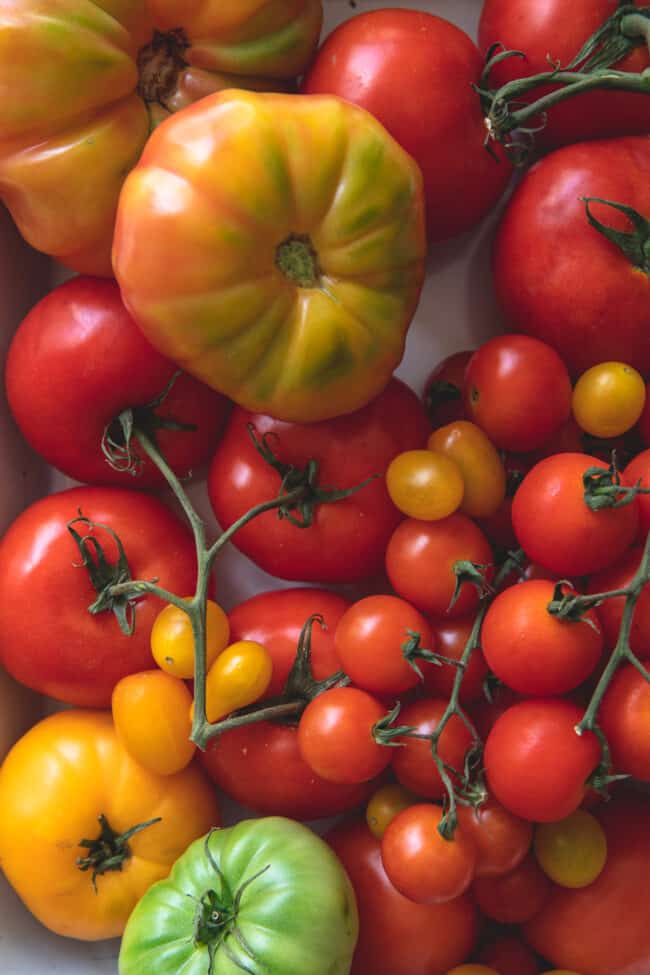Tomatoes
Here’s everything you need to know about tomatoes, like are tomatoes a fruit or a vegetable? What are the different types of tomatoes you can choose from (like Roma tomatoes and cherry tomatoes)? How to add more of them to your diet. Plus 50 Recipes Using Tomatoes to give you inspiration.

What can you make with tomatoes? There’s so many different types of tomatoes, so the possibilities are endless really! I’ve listed 50 tomato recipes in this article to help you incorporate more tomatoes into your diet.
What are Tomatoes?
Tomatoes are fruits from the plant Solanum lycopersicuma. They’re a member of the nightshade family, along with potatoes, eggplant and bell peppers. They’re typically red in color when they’re ripe, but they also come in a variety of shapes, sizes and colors (yellow, orange and green). The water content found in tomatoes is about 95% and the remaining 5% consists of fiber and carbs. All of them (like Roma tomatoes to cherry tomatoes) are a good source of vitamin C, vitamin K, lycopene, beta-carotene, potassium and folate, making them a good food to add to your diet. Be sure to check out the 50 tomato recipes at the end of this article.
Are they a Fruit or a Vegetable?
Defining a fruit or a vegetable depends on if its being classified botanically or in culinary terms. Botanically speaking, tomatoes are a fruit, more specifically a berry, but they are prepared and served as a vegetable. All fruits have a seed or seeds and are formed from flowers. Vegetables on the other hand are the roots, stems and leaves of plants like carrots, celery, beets and lettuce. But when it comes to cooking, the classification system changes a bit for fruits and vegetables. Fruits are considered sweet, so they tend to be used more for desserts, smoothies and jams. Vegetables tend to have a more bitter with a tougher texture. They can be eaten raw, but oftentimes they’re better off cooked. Vegetables are most often used for savory dishes like soups, stews and casseroles.
Types of Tomatoes
There are many types of tomatoes to choose from (like Roma (also called Italian and plum tomatoes), cherry(also called sweet tomatoes) and heirloom). Some are better to toss in salads, while others are better to use for sauces. They’re all rich with vitamin C, beta-carotene and lycopene and they’re all low in calories. Here are 7 common types of tomatoes and their suggested uses:
Beefsteak
These are generally on the larger side up to 6 inches in diameter. These are meatier with a high flesh-to-seed ratio. They are typically firm and hold their shape while slicing them. These are perfect for adding to sandwiches and burgers.
Cherry Tomatoes (Sweet Tomatoes)
These are little round, bite-sized, sweet and juicy tomatoes (also called sweet tomatoes). Cherry tomatoes are most often tossed in salads, pan roasted to serve with chicken or fish, or enjoyed as a snack and served with crudites.
Grape
These are about half the size of a cherry tomato and they have an oblong shape. They have little juice, only contain about 1 calorie per tomato. They can be tossed in salads, enjoy as a snack and serve with crudites.
Roma Tomatoes (Italian and Plum)
Roma are also called Italian and Plum tomatoes. They contain little water and seeds. Roma tomatoes are great to add to to salads and sauces.
Heirloom
These range is size, shape and color. They are non-hybrids and their seeds are saved and without cross pollinating with other types of tomatoes. These are often used for canning, making sauces or tossing wedges in with a salad.
Garden
You’ll find these at the store still attached to the vine they grew on. Vine ripened tomatoes may have higher amounts of antioxidants and other vitamins and minerals than those picked before peak ripeness. These are great sliced for sandwiches and used to make homemade sauces with. (1)
Green
There are two types of green, heirloom that are green when fully ripe and those that are not yet fully ripe and will turn red. The unripened version are usually used to make fried green tomatoes or they’re sliced for sandwiches.
Choosing the Best
There are so many different types of tomatoes, but when choosing the best to buy, always (no matter the type), look for plump, heavy tomatoes with smooth skins free of bruises, blemishes or cracks. Their leaves should look fresh and green. Choose whatever size you need for your intended use. The size doesn’t have any bearing on flavor, texture or quality.
How Long Do They Last?
There’s no precise answer to this, because it depends on how ripe they are when you buy them, how you store them and whether you refrigerate them or not. Typically they will last on the counter for up to 7 days, but keep them away from direct sunlight. Fully ripe tomatoes can be stored in the refrigerator for a day or two, but if you keep them there any longer, you will have a watered down, mealy and mostly tasteless tomato on your hands. Don’t put them unripe in the refrigerator because this will stop the ripening process.
Want to know more? Go to How to Store Tomatoes for more tips and tricks for storing them.
Tomato Products
Besides fresh off the vine tomatoes, tomatoes are sold in a variety of other forms. Canned and processed tomato products are more concentrated so they can possibly have up to five times the lycopene. Processed tomatoes are also cooked, so they may be easier for the body to absorb the lycopene that they provide. Some canned tomatoes are quite high in sodium, so be sure to always check the label before buying. Some of the tomato recipes I’ve provided below, utilize canned tomatoes.f The following are some of the more common products used in recipes:
Whole
These are often made from Roma (or plum), and they’re made with whole ripe tomatoes that have been cooked peeled and cored. Great for long simmering recipes like soups, sauces and stews.
Diced
These are great for stews and chunky sauces.
Crushed
These are often used for making soups and sauces.
Stewed
These are typically stewed with onion, green pepper and celery and seasonings like oregano and thyme. Often added to soups and stews.
Paste
This is a very concentration form of juice. Typically the concentration is 24% from solids (as opposed to the 8%-24% for tomato puree). Often used to thicken sauces and add flavor to soups and stews.
Puree
This is also a concentration form juice and pulp and it has the consistency of thick tomato sauce. Often used in sauces and salsas.
Sauce
Used to make pasta sauces, salsas and to add flavor to rice and soups.
Sun-dried
These are made from Roma (plum) that have been dehydrated which preserves them and provides a rich flavor. They’re sold packed in oil or dry. If you purchase the dry, you’ll likely need to soak them in water first before adding them to a dish.
Juice
This is made from blending and straining the liquid from tomatoes.
How to Add More of Them to Your Diet (50 Recipes With Tomatoes)
If you’re looking for ways to incorporate more tomatoes to your diet, we’ve got you covered! Here’s 50 recipes with tomatoes for inspiration. Chick the recipe name to take you to the full post.
Breakfast
- Add slices of tomato to toast drizzled with olive oil and sprinkled with salt and freshly ground black pepper
- Add them to Vegan Breakfast Skillet, Simple Spinach Leek Onion Frittata, Tomato Basil Scrambled Eggs, and this Breakfast Salad
Dips
- Use fresh tomatoes to make Pico de Gallo or use canned to make Restaurant Style Salsa
Extras
- Add them as a pizza topping like we did with this Tortilla Pizza
- Use Roma Tomatoes to make sun-dried tomatoes
Salads
- Toss into leafy green, quinoa, lentil, bean and pasta salads like this Avocado Tomato Salad, Italian Chopped Salad, Romaine Salad, Lentil Salad, Italian Tuna Pasta Salad, Basil Pesto Chicken Salad, Everyday Mediterranean Salad, Best Quinoa Salad, Mediterranean Cauliflower Cauliflower Salad, Southwest Quinoa Salad, Celery Salad, Chef Salad, Black Bean and Corn Salad, Everyday Tossed Salad, House Salad, Fried Chicken Salad, Crunchy Tabbouleh Salad and Mediterranean Chickpea Cucumber Salad
- Hollow them out and fill with tuna salad, egg salad or chicken salad like this Tuna Salad, Chickpea Tuna Salad, Healthy Italian Chicken Salad, Tarragon Chicken Salad, Avocado Chicken Salad, Avocado Egg Salad, Loaded Low-Fat Egg Salad
Sandwiches
- Layer in slices of tomato the next time you make a grilled cheese sandwich
- Add slices to sandwiches and burgers like this Mediterranean Tuna Melt, Chopped Cheese, Tuna Salad Sandwich and Mexican Avocado Chicken Burgers
- Blend sun-dried tomatoes with mayonnaise to make a delicious sandwich spread
Sauces
- Make a quick and easy Marinara Sauce to serve with pasta, chicken or to use as a dip with Baked Zucchini Chips
Sides
- Use to make side dishes like this Spanish Rice, Spanish Quinoa and Mexican Cauliflower Rice
Soups And Stews
- Toss chopped fresh, frozen or canned tomatoes into soups, stews, skillets, casseroles and one-pot meals like this Italian Lentil Soup, Mexican Chicken Rice Soup, Easy Minestrone, One Pan Italian Chicken, Enchilada Style Baked Chicken, Caldo de Pollo, Hearty Lentil Stew, Turkey Enchilada Casserole, Chicken Picadillo Bowls, Chicken Continental, Vegan Tortilla Soup, Mexican Lentil Soup and Chicken Tortilla Soup
More Resources
- Spinach – Learn all about spinach, how to choose it, store it, use it, plus recipes.
- Arugula – Learn about arugula, the benefits, how to use it, plus recipes.
- Quinoa – Learn everything you need to know about quinoa, how to cook it, plus recipes.
- Lentils – Learn about the different types of lentils, how to cook them, how to use them, plus recipes.
- Parsley – Learn about the benefits of parsley, different types and how to use it.



